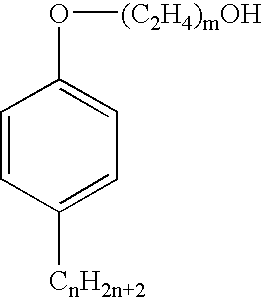Resin composition
a technology of resin composition and composition, applied in the field of resin composition, can solve the problems of phase separation in resin composition inability to meet the requirements of polyol and blowing agent, and failure to overcome phase separation problems in resin compositions used to form flexible foam, etc., to achieve the effect of improving the flowability of resin
- Summary
- Abstract
- Description
- Claims
- Application Information
AI Technical Summary
Benefits of technology
Problems solved by technology
Method used
Image
Examples
examples
[0044] A resin composition including an alkoxylate as a compatibilizer was formed according to the subject invention. An experimental resin composition was also formed that did not include the alkoxylate as the compatibilizer. The experimental resin composition included glycerin as a traditional blowing reaction modifier, in place of the alkoxylate. The resin compositions including the alkoxylate and the experimental resin composition lacking the alkoxylate were visually evaluated to determine if phase separation occurred after the resin compositions were allowed to stand overnight at room temperature (70° F. / 21° C.).
[0045] Specific components included in both the resin compositions including the alkoxylate and in the experimental resin composition are set forth in Table 1. All components are in parts per one hundred parts polyol unless otherwise noted. Further, any percentages indicated in Table 1 are based on 100 parts of the total resin composition.
TABLE 1Resin CompositionComp...
PUM
| Property | Measurement | Unit |
|---|---|---|
| viscosity | aaaaa | aaaaa |
| viscosity | aaaaa | aaaaa |
| viscosity | aaaaa | aaaaa |
Abstract
Description
Claims
Application Information
 Login to View More
Login to View More - R&D
- Intellectual Property
- Life Sciences
- Materials
- Tech Scout
- Unparalleled Data Quality
- Higher Quality Content
- 60% Fewer Hallucinations
Browse by: Latest US Patents, China's latest patents, Technical Efficacy Thesaurus, Application Domain, Technology Topic, Popular Technical Reports.
© 2025 PatSnap. All rights reserved.Legal|Privacy policy|Modern Slavery Act Transparency Statement|Sitemap|About US| Contact US: help@patsnap.com



